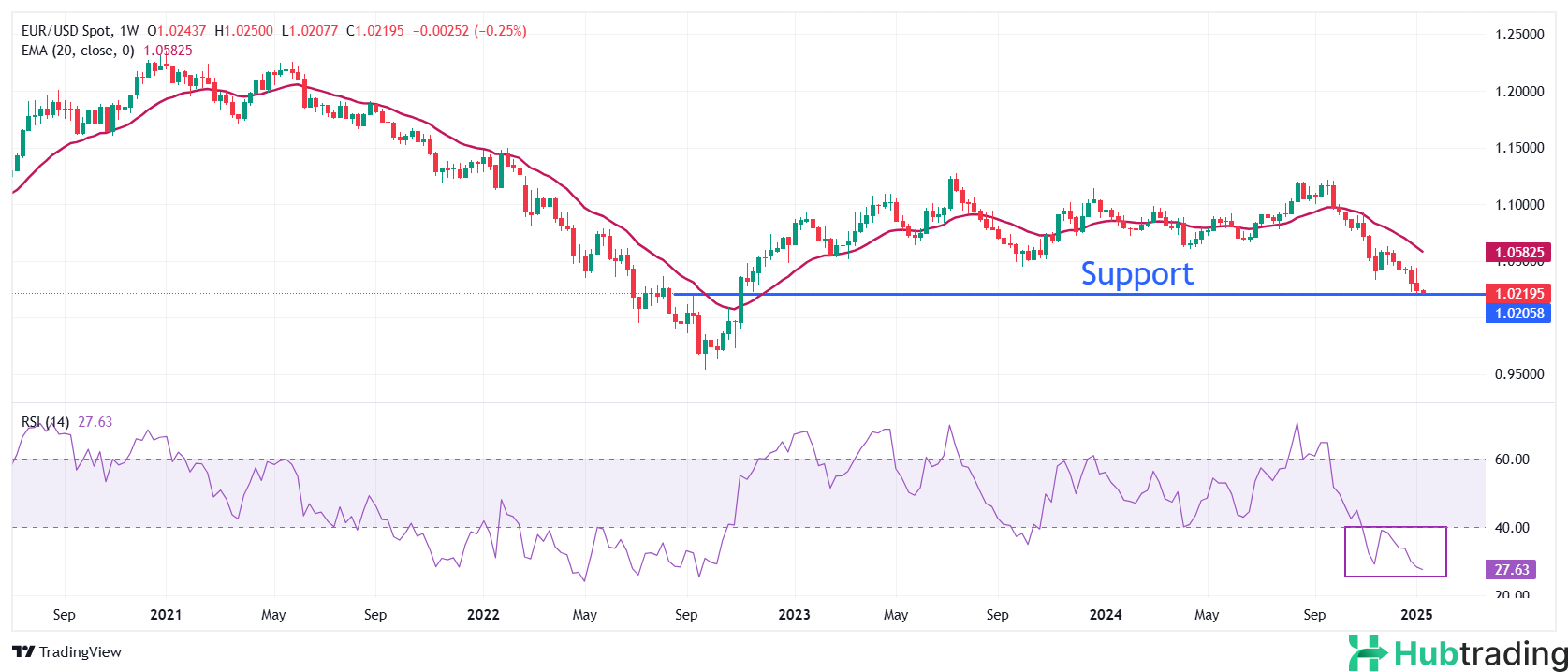- EUR/USD drops to near 1.0200 as the US Dollar stays strong, driven by expectations that the Fed will cut rates only once this year.
- Traders scale back dovish bets on the Fed following the release of strong US Nonfarm Payrolls data for December.
- ECB’s Lane advocates for further rate cuts to prevent the Eurozone from experiencing sluggish growth.
EUR/USD drops to a fresh two-year low near 1.0200 at the start of the week, as the US Dollar strengthens amid rising bond yields. The US Dollar Index (DXY), which measures the Greenback against six major currencies, surges to nearly 110.00, its highest level in over two years. 10-year US Treasury yields near a yearly high of around 4.75% further support the USD's strength.
The rally in US bond yields comes as speculation grows that the Federal Reserve's (Fed) policy-easing cycle has paused. Dovish expectations for the Fed were dampened by strong US Nonfarm Payrolls (NFP) data for December, which showed a higher-than-expected increase in jobs and a decline in the Unemployment Rate.
Bank of America (BofA) noted that given the resilient labor market, the Fed’s rate-cutting cycle is likely over, with the economic activity remaining "robust" and inflation risks leaning to the upside. According to the CME FedWatch tool, the Fed is unlikely to cut rates before its June policy meeting.
This week, market focus will shift to the upcoming release of the US Producer Price Index (PPI) and Consumer Price Index (CPI) data for December, scheduled for Tuesday and Wednesday, respectively.
Daily Digest Market Movers: EUR/USD Declines as ECB’s Lane Acknowledges Need for More Rate Cuts
- EUR/USD faces downward pressure amid weak market sentiment, which has negatively impacted the Euro (EUR). Investors have become more risk-averse due to growing uncertainty over the potential impact of protectionist policies under US President-elect Donald Trump, sparking fears of a global trade war that could diminish the appeal of risk-sensitive assets.
- Trump has reportedly considered declaring a national economic emergency, which would provide a legal basis for imposing new tariffs. During his election campaign, Trump warned that the European Union (EU) could "pay a big price" for not purchasing enough American exports.
- Domestically, persistent expectations of further policy easing from the European Central Bank (ECB) weigh on the Euro. In a "policy dialogue" at the Asian Financial Forum (AFF) 2025 on Monday, ECB Chief Economist Philip Lane indicated that additional rate cuts are likely, as the ECB aims to prevent the economy from growing "too slowly." Lane emphasized the need for a balanced approach, saying the ECB should be “neither too aggressive nor too cautious” in its policy decisions this year.
- Additionally, ECB policymaker and Deputy Governor of the Croatian National Bank, Boris Vujčić, expressed comfort with market speculation of more rate cuts, but cautioned against accelerating the current pace of policy easing, favoring a more gradual approach amid ongoing uncertainty.
Technical Analysis: EUR/USD Slumps to Near 1.0200
EUR/USD declines toward key support near the 1.0200 level, a crucial point marked by the September 2022 high on the weekly chart. The outlook remains predominantly bearish, with the 20-week Exponential Moving Average (EMA) at 1.0580 showing a downward slope.
The 14-week Relative Strength Index (RSI) has fallen below 30.00, signaling strong downward momentum.
On the downside, the pair could find support around the psychological level of 1.0100. On the upside, the January 6 high of 1.0437 will act as a key resistance level for Euro bulls.






